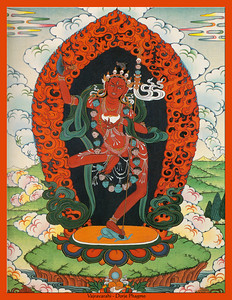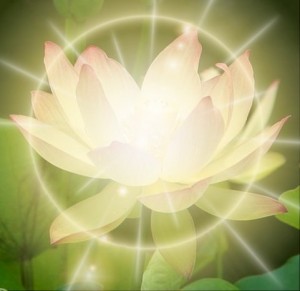An excerpt from a teaching called The Eight-Fold Path by Jetsunma Ahkon Lhamo
Right view should be understood as the underpinning, the beginning and the ending, and everything in between on the path. It is in some ways the essence, the essential nectar drop of the path. In right view through meditation, through contemplation, and through receiving teachings, we come to understand the nature of samsara. We meditate on samsara and understand its flaws, its faults, and how it is so confusing to all of us. By understanding the nature of samsara, we know what to avoid and what to pick up. But without contemplating on and understanding the nature of samsara by remaining constantly in a reactive stage, there will be no accomplishment. We grasp what is impermanent, what is imperfect. We begin to contemplate and study the empty nature of phenomena. That phenomena is what it seems to be, yet even now we know from the scientific world that it isn’t what it seems to be. It seems to be this way, but we know that it isn’t. We know that for instance that on the surface, the nature of glass, the nature of wood, the nature of material, all of it is basically molecules with a bunch of space in them. And so while they appear solid, its all really energy, electromagnetic energy that binds molecules together. It is not the way it appears to be. We have the habit of seeing what we see. But when one is awake, phenomena is basically empty of self-nature. And subtle energies, the very display that is samsara is understood in its nature.
In order to attain right view, you don’t have to be smart. Even though the people that are teaching it often use these wonderful big words, “all pervasive this,” and “foundational whatever.” And you think, “Wow, this sounds like you have to have a PhD to understand this.” And it’s not true. Correct view or right view isn’t about smart. It’s about wisdom. It’s about experience through contemplation and meditation. Even if you don’t have the big words, you can have a direct experience through contemplation. It begins with the insight that is brought to bear by having meditated on the Four Noble Truths in that we understand that all sentient beings are suffering. We begin to realize that desire is the problem, to understand the nature of reaction and attachment, and to understand the nature of phenomena and the truth that the Buddhas and the bodhisattvas prevail and are indeed omniscient and powerful. They have brought us the path and they remain. In other words it is the awareness and belief in the Three Precious Jewels – Buddha, Dharma and Sangha.
We all have view. We have view right now. We are viewing each other. I’m viewing this lady’s pretty necklace, and I’m viewing my daughter, and I’m viewing you. We have it. Whatever we think in our mind, when we are viewing, this is our view.
To practice Right View, one trains the view. One trains so that when you look at somebody you don’t say, “I like him or I don’t like him.” You don’t react with attachment or repulsion. Right View means that you train yourself to see differently what is. For instance, say I am Caucasian and you are a black man. I look at you. If I say to myself, “Oh, I’m Caucasian, and he’s a black man.” That’s my view. That’s what I’m seeing. And in the Buddha dharma, it is not correct view. Not correct at all. Because we are to understand that within each of us, we are equal and we have the Buddha nature and that view is so completely superficial. If we look at someone else from another culture or family or another planet, and see only the differences, right view would be to correct that. It would be to see the sameness, to wake up to the fact that all sentient beings are inherently equal and that we share the same nature. I may be one color and you may be another but we share the same nature, and there is no color on that nature. So, this is where you begin. You see how this is a foundation where you become mindful and thoughtful? It’s not a generation stage practice where you are actually doing a puja, but it’s where you contemplate the fundamental meaning of the path. Having trained oneself in Right View, its so much easier later on when you begin to approach the bodhisattva vow and the compassion that we learn in Mahayana Buddhism, because with Right View as the foundation, we are half way there. We can have compassion for others. We can uphold others as the same as ourselves. And we can do for others what is kind and good to do. If we understand Right View properly and we have done the preliminary contemplations, then in Vajrayana it is much easier to have proper view with Vajrayana meaning.
In Vajrayana meaning we should see every female as the goddess, and every male as a god. We see each being in their truer nature. And we respect the women as being dakinis. We respect the men as being dakas. We respect, that is the View in Vajrayana. And nobody’s higher than anybody else except in the practice of Guru Yoga where we actually use the Guru as a focus to understand our own nature. But we’re not there yet. We’re still on Right View.
So it behooves us to contemplate the meaning of this, and how to approach viewing others, viewing your life, viewing your potential, and viewing the world at large. This is mind training. This is where you train your mind. If you don’t train your mind here, when you get to the higher levels of practice, you are too wobbly and unstable. You can practice real well for a while, but then you are gone. You must have this underlying stability, this understanding in order to really practice the path well and keep flourishing on it.
© Jetsunma Ahkon Lhamo







![buddha5ascetics28[1]](https://www.tibetanbuddhistaltar.org/wp-content/uploads/2010/09/buddha5ascetics281-234x300.jpg)

